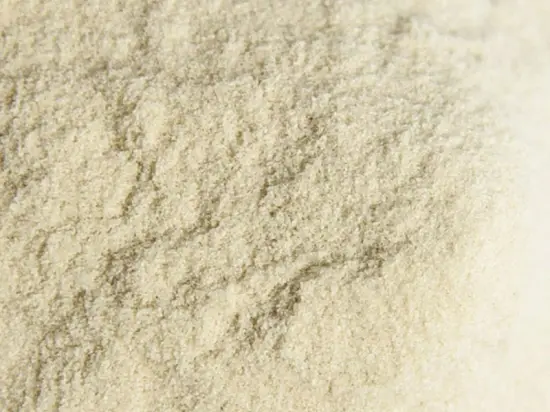
Sodium alginate (1d401)
- 1d401
- Heat resistant, fat soluble, water binding properties
- Gelling agent
- Coating agent
On Demand weeks

Introduction: Sodium alginate (1d401)
What is Sodium alginate?
Sodium alginate is a natural polysaccharide that is extracted from brown seaweed, particularly from species such as Macrocystis pyrifera, Ascophyllum nodosum, and Laminaria digitata. It is commonly used in the food industry as a thickener, stabilizer, and emulsifier due to its ability to form a gel when it comes into contact with calcium ions.
How is Sodium alginate being produced?
Sodium alginate is extracted from brown seaweed using a process called "alkali treatment". The seaweed is first harvested and washed to remove any impurities such as sand, salt, or other debris. Then, it is chopped into small pieces and treated with a dilute alkaline solution, typically sodium hydroxide or potassium hydroxide, which breaks down the cell walls and releases the alginate into the solution.
The resulting solution is then filtered to remove any remaining seaweed solids, and acidified with a mineral acid such as hydrochloric acid or sulfuric acid. This causes the alginate to precipitate out of the solution as a gelatinous mass.
The alginate gel is washed with water to remove any residual salt or acid, and then dissolved in a solution of sodium carbonate or sodium hydroxide to form sodium alginate. The solution is then further processed to remove any impurities and standardized to a desired viscosity and purity.
The final product is a white or yellowish powder that is soluble in water and forms a thick gel when exposed to calcium ions. The purity and quality of sodium alginate can vary depending on the source of the seaweed, the extraction process, and the degree of processing it undergoes.
In which industries can Sodium alginate be used?
Sodium alginate is commonly used as a thickener, gelling agent, stabilizer, and emulsifier in a variety of food products such as ice cream, yogurt, cheese, sauces, dressings, and bakery products. It is also used to form spheres and other shapes in molecular gastronomy.
Sodium alginate is used as a printing paste in the textile industry to create patterns on fabrics. It is also used as a thickener in the dyeing process and as a sizing agent to improve the texture and strength of fabrics.
Sodium alginate is used as a binder, thickener, and disintegrant in the formulation of tablets, capsules, and other pharmaceutical products. It is also used as a delivery vehicle for controlled-release drugs.
Sodium alginate can be used in the formulation of cosmetics and personal care products such as lotions, creams, and gels. It can improve the texture and stability of these products and also act as a moisturizer.
Sodium alginate is also used as a biomaterial for tissue engineering and wound healing. It can be used to create scaffolds for cell growth and to promote the healing of wounds and burns.
Overall, the versatility and safety of sodium alginate make it a useful and valuable ingredient in various industries.
Typical applications: Sodium alginate (1d401)
Typical applications
Sodium alginate is probably better known under th E-number "1d401" and can be found on the ingredient lists of many foods.
Sodium alginate is the sodium salt of alginic acid. Alginic acid is a naturally present, edible polysaccharide found in various brown algae.
With the addition of calcium ions, sodium alginate forms a gel which is stable to cooking, freezing and baking. As a coating agent, sodium alginate lends stability to foods. This means they retain their shape even after freezing and thawing. Additionally, sauces and dessert become creamier as fat and water mix more easily after the addition of sodium alginate.
Besides its popularity in the food industry, sodium alginate also finds use in the production of animal foods, fertilizers and pharmaceuticals.
This product is available in the following froms: Sodium Alginate powder.
Sources:
- Alginic acid - Wikipedia (https://en.wikipedia.org/wiki/Alginic_acid)
- Wang H, Yang L, Yang Y. A review of sodium alginate-based hydrogels: Structure, mechanisms, applications, and perspectives. Int J Biol Macromol. 2025 Mar;292:139151. doi: 10.1016/j.ijbiomac.2024.139151. Epub 2024 Dec 24. PMID: 39725117. (https://pubmed.ncbi.nlm.nih.gov/34364633/)
- Sanchez-Ballester NM, Bataille B, Soulairol I. Sodium alginate and alginic acid as pharmaceutical excipients for tablet formulation: Structure-function relationship. Carbohydr Polym. 2021 Oct 15;270:118399. doi: 10.1016/j.carbpol.2021.118399. Epub 2021 Jul 1. PMID: 34364633. (https://pubmed.ncbi.nlm.nih.gov/34364633/)
- Vicini S, Castellano M, Mauri M, Marsano E. Gelling process for sodium alginate: New technical approach by using calcium rich micro-spheres. Carbohydr Polym. 2015 Dec 10;134:767-74. doi: 10.1016/j.carbpol.2015.08.064. Epub 2015 Aug 22. PMID: 26428184. (https://pubmed.ncbi.nlm.nih.gov/26428184/)
- Hassanisaadi M, Kennedy JF, Rabiei A, Riseh RS, Taheri A. Nature's coatings: Sodium alginate as a novel coating in safeguarding plants from frost damages. Int J Biol Macromol. 2024 May;267(Pt 1):131203. doi: 10.1016/j.ijbiomac.2024.131203. Epub 2024 Mar 28. PMID: 38554900. (https://pubmed.ncbi.nlm.nih.gov/26428184/)
- Wang T, Yi W, Zhang Y, Wu H, Fan H, Zhao J, Wang S. Sodium alginate hydrogel containing platelet-rich plasma for wound healing. Colloids Surf B Biointerfaces. 2023 Feb;222:113096. doi: 10.1016/j.colsurfb.2022.113096. Epub 2022 Dec 15. Erratum in: Colloids Surf B Biointerfaces. 2025 Apr;248:114462. doi: 10.1016/j.colsurfb.2024.114462. PMID: 36542954. (https://pubmed.ncbi.nlm.nih.gov/36542954/)

ALGANEX certificate system
Reply within twelve hours